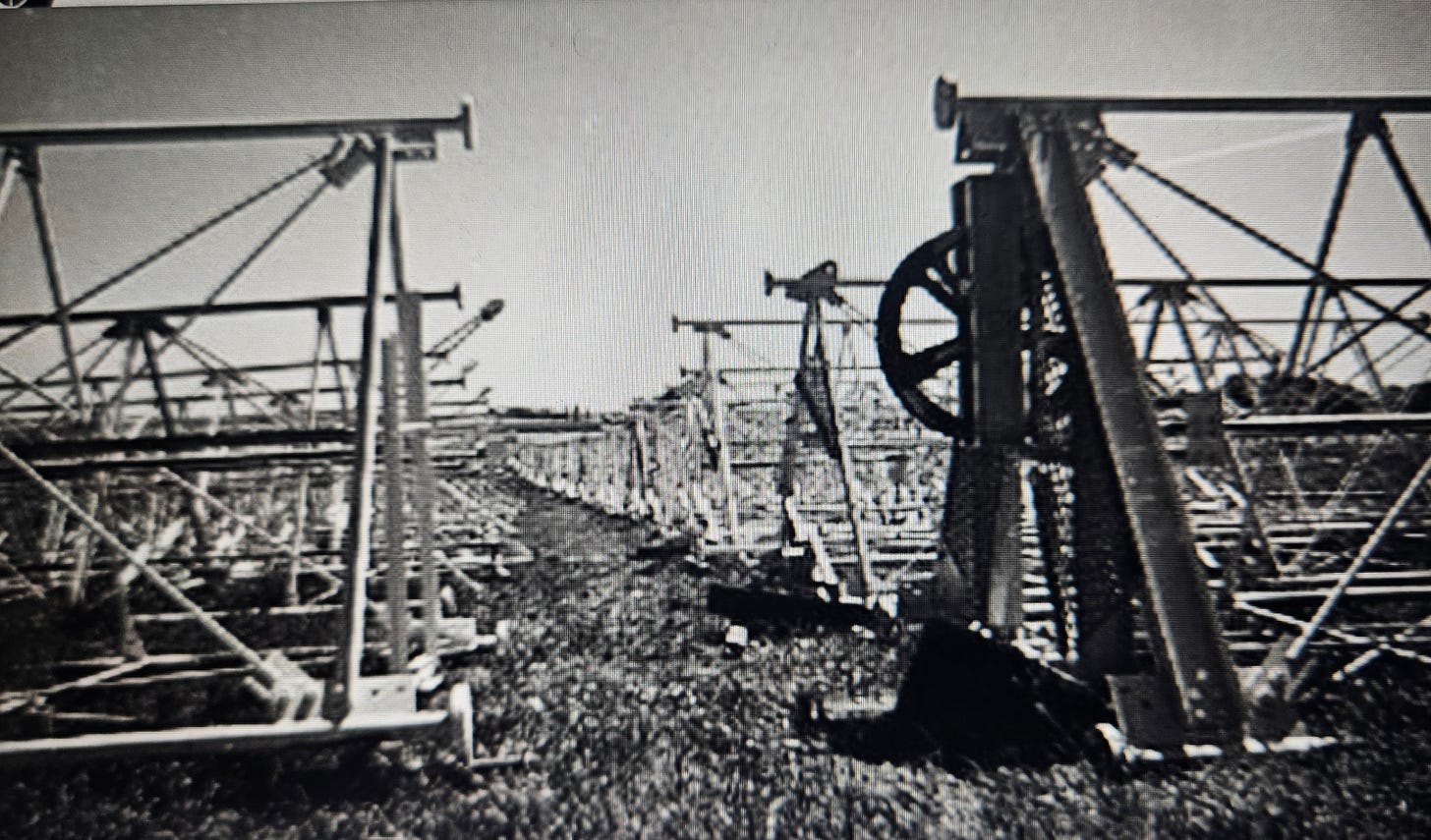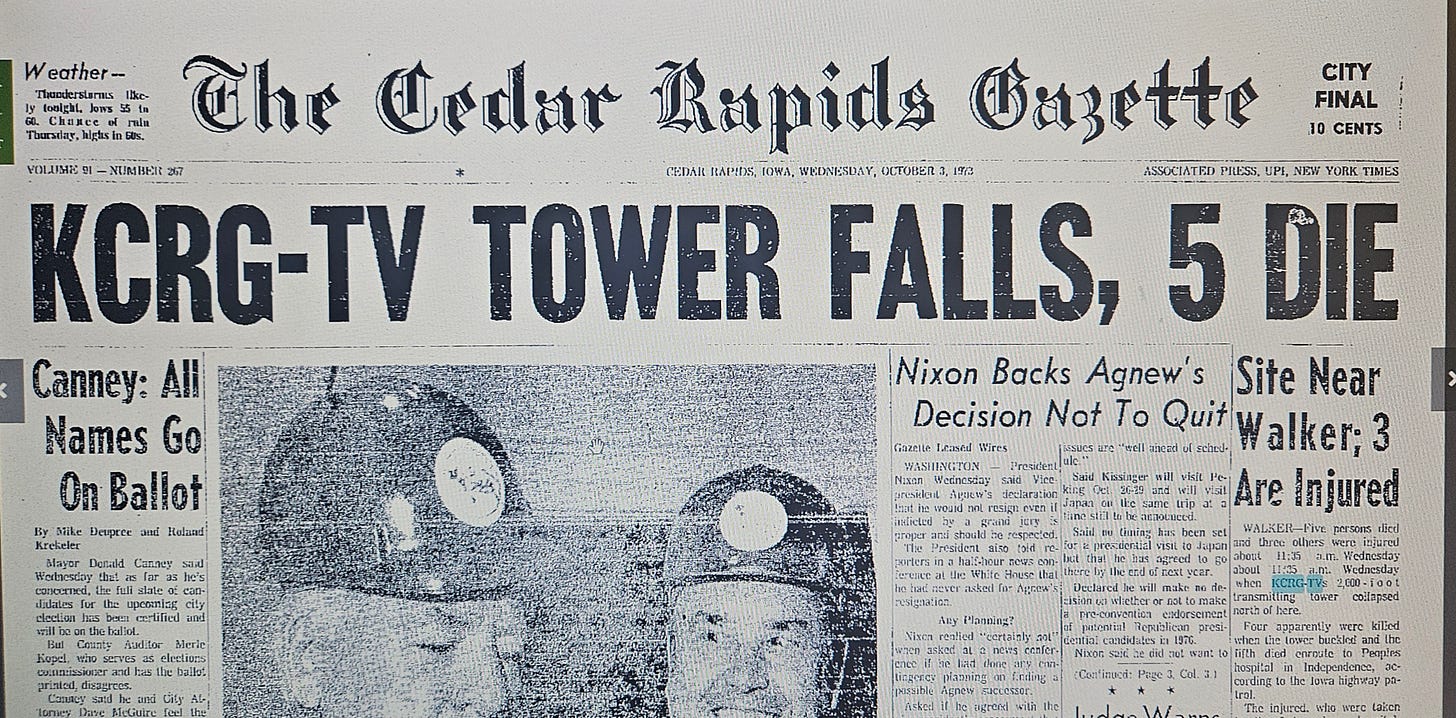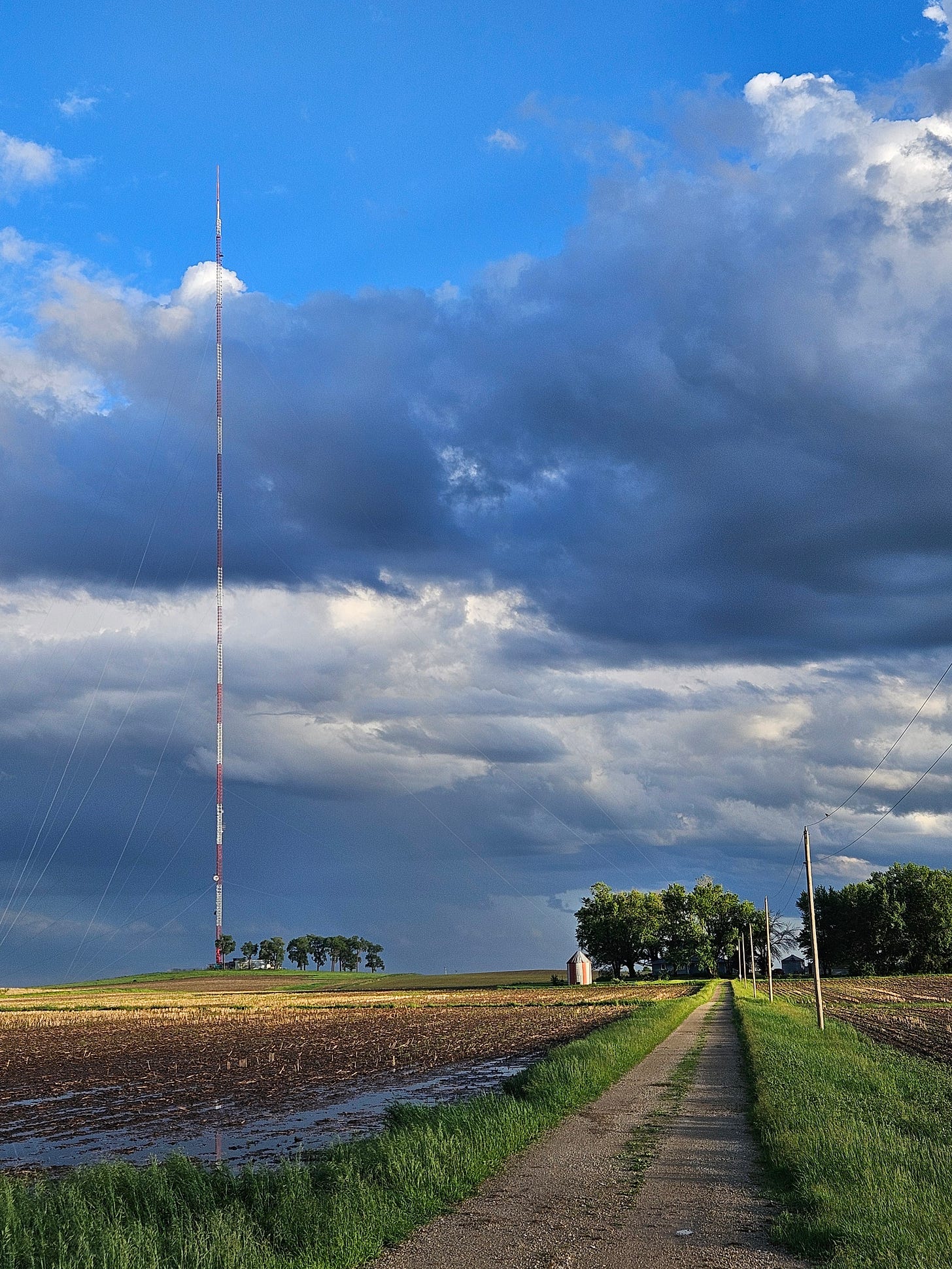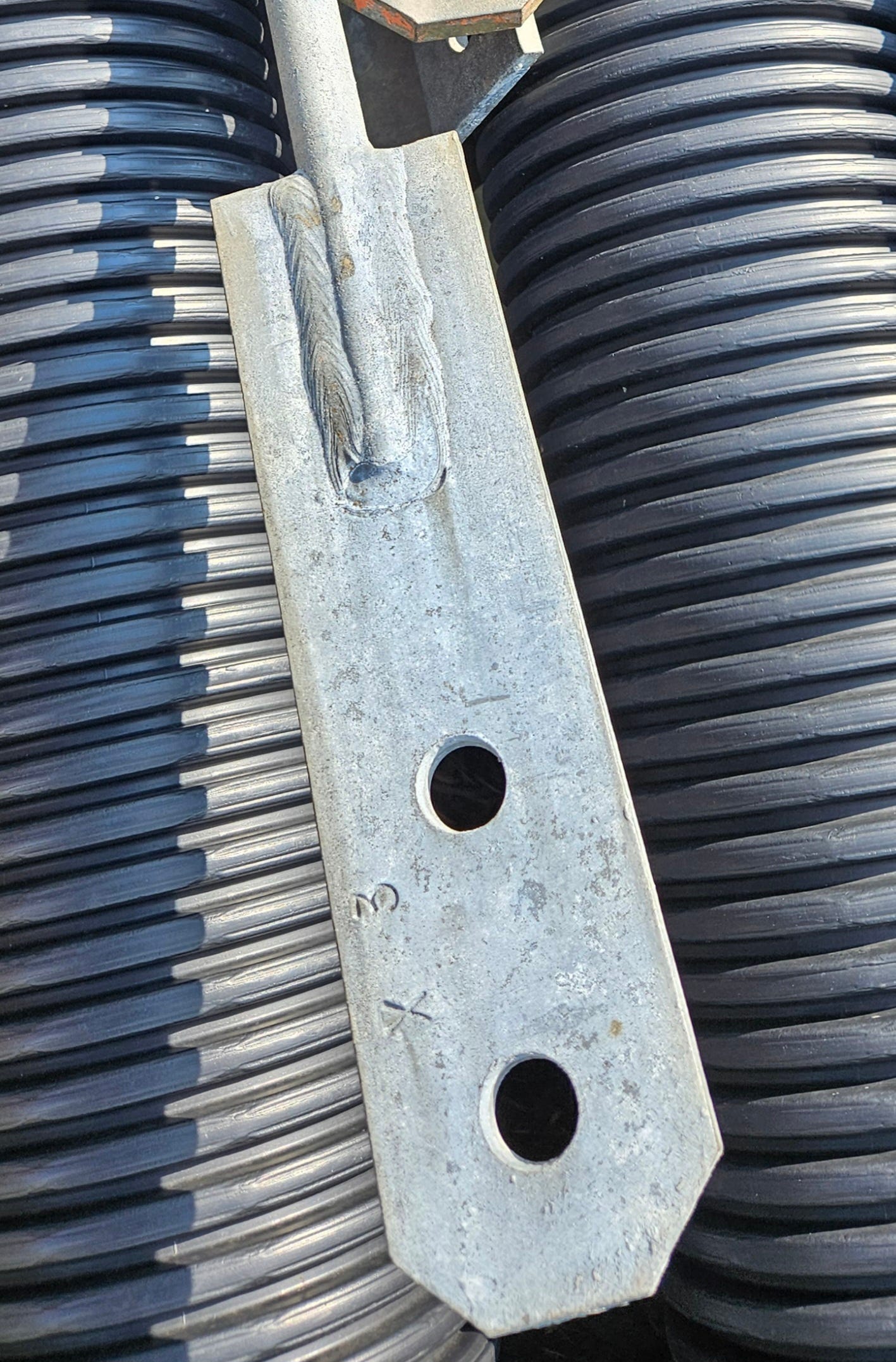Four TV Towers Within Five Miles, Pt 3--KCRG's Destruction
Built in 1967, the channel 9 tower killed five when it collapsed in 1973
I decided to shorten the original title of this blog series.
I grew up in northeast Iowa, in an ideal geographic area for raising tall corn and giant television towers. Over the past seventy years, all three of the huge structures serving the Cedar Rapids-Waterloo market have fallen for various reasons. I also lived in Fort Dodge in 1977 when a tornado weakened the KVFD-TV tower, causing it to be brought down the following week.
In my last blog, I described the CONSTRUCTION of KCRG-TV’s 2000-foot tall tower in 1967. This describes the tragic DESTRUCTION of that same tower in 1973.
Here’s part 3 of “Four TV Towers that Have Fallen within Five Miles of Places I’ve Lived.”
—
John Devere Grover went by either “JD” or “Devere.” I called him Grandpa Grover. He had Rowley’s rural mail route for nearly forty years. Fortunately for his family, this served as steady, middle-class employment during the Depression. The income probably also helped subsidize his eighty-acre farm.
Grandpa is part of the reason you don’t see huge rocks on farms anymore. Born in 1898, he raised hogs, cattle, chickens, corn, oats and hay. As a side hustle, farmers sometimes called him to dynamite massive granite “erratics” that littered their cornfields thanks to glaciers.
He still did this once in awhile in his mid-seventies.
—
Today it’s called a “personal day.”
Early on Wednesday, October 3, 1973, I told Mom I had a sore throat, probably still raw from yelling during our football game the preceding Friday night. I was a benchwarmer (today>”special teams”) on the Independence Mustang squad that was halfway through the high school’s only undefeated season. We had a nail-biter a few nights earlier with a 13-12 win over Wamac rival Tipton. (Truth be told, I didn’t really want to go to football practice that Wednesday).
I turned on KCFI (in the days of AM top 40), listening for Ramblin Man, China Grove, Jim Croce, and the other songs/artist that made an imprint on my sixteen year old psyche. I laid in my upstairs bed, windows open wide in the pre-AC days, probably reading Ray Bradbury. Just before lunch, a distant rumble filled the air. Looking west past an ancient tree and a newly-planted windbreak, the sky was robin's-egg blue and nothing stirred the early-autumn ash leaves.
Not thunder, I thought. Maybe Grandpa Grover blowing up rocks?
I dove back into reading Dandelion Wine.
—
ABC affiliate KCRG-TV had constructed a 2000-foot tower in 1967 about three miles south of our farm. In addition to broadcasting their own signal, they had added an antenna for use by Waterloo-based KWWL-TV. Two FM radio stations also used the tower.
KCRG tower sections on the ground during construction. Cedar Rapids Gazette, May 24,1967.
Several years later, the FCC ruled the KWWL antenna had to be removed due to mileage separation requirements with WGEM-TV in Quincy, Illinois that shared channel 7’s spot on the dial. After the removal was completed, a new fifteen-ton antenna and other equipment would be added to the tower for the Iowa Education Broadcasting Network to broadcast public television and radio programming.
Work got underway in the summer of ‘73 and KCRG the project had been going smoothly until October 3rd.
Front page of the Cedar Rapids Gazette, October 3, 1973.
As lunchtime approached that morning, Leo Halsch said “it sounded like the end of the world.” He worked as a transmitter engineer at the base of the tower. “The transmitter dropped out and things began falling all around me. I jumped under the console. It was indescribable…I just stood there and shook.” He went outside to see the tower had fallen. “All I saw were limbs and pieces of bodies all over.”
Virgil Ellison, who was operating a winch at the tower’s base, heard creaking before the guylines began vibrating. He and another worker ran into a cornfield as the tower collapsed.
Hazel Kout was having lunch with her husband Joe. He worked as a technician for the nearby WMT-TV tower. Hazel told the Cedar Rapids Gazette it “fell down in a big heap, like an accordion.” She immediately called the Independence hospital to send an ambulance.
Five men were killed that morning. According to the Waterloo Courier, four more suffered injuries.
Neighbor Mrs.Terry Carson saw it fall with her young daughter. “There was a big rumble…like a low flying airplane, and it just crumbled.” A registered nurse, Carson rushed to the scene to see if she could help. She saw two bodies about sixty feet from the tower’s base. Another body lay near a car.
By 12:30, the Gazette reported authorities had recovered four bodies from the massive twisted and pancaked steel. A fifth victim was found buried in the rubble at the tower’s base.
Leo Halsch thought the tower collapsed as four men were changing cross braces at the 1900-foot level of the 2000-foot tower. An eyewitness claimed the men were between 400 and 500 feet above the ground.
The four men on the tower worked for Clark-Olsen, an engineering company from Port Washington, New York. Also killed was Elmer Greiner–a 47 year-old father of eight–who was employed by Hoffman Construction. The four injured men worked for either Hoffman or Elm Park Plumbing and Heating, both located in Independence, Iowa.
The story got a ten-second mention on CBS News with Walter Conkrite and dominated local media for several days.
KCRG tower wreckage, Cedar Rapids Gazette, Oct 3, 1973.
“The loss of lives and injuries is a terrible tragedy,” said J.F. Hladky Jr, president of Cedar Rapids Television Company. He noted that consulting engineer Gunnar Olsen had verified that the tower was structurally capable of adding the IEBN antenna. Hladky estimated KCRG would be off the air for several weeks while arrangements were made to activate their back-up tower near Hiawatha.
OSHA officials arrived on the scene that afternoon and expected to have a preliminary report in about a week. KCRG General Manager Ed Lasko noted the tower was inspected annually and had been checked ten months earlier. Lasko said the tower had cost about $500,000 to build, and estimated damages at $750,000.
Since the tower didn’t fall directly onto the transmitter building, workers were able to move equipment to KCRG’s back-up tower near Hiawatha beginning that afternoon. Working around the clock, technicians had channel 9 back on the air two days later.
Walt Alliss Jr, KCRG Chief Engineer, described the process. “Area farmers, service station workers, and other area residents manned sledge hammers and knocked the wall out of the damaged transmitter house.”
The transmitter was “disassembled piece by piece, marked and loaded onto trucks” and transported to Hiawatha. Once again a wall had to be knocked down to reassemble the equipment. Electricians, welders, and technicians from both RCA and KCRG helped restore the signal to a smaller coverage area.
A story in the July 11, 2019 Gazette recalled that tragic day and its aftermath. An agreement had been reached in January 1974 to rebuild on the site of the fallen KCRG tower. Construction stalled when a family filed a lawsuit against the tower’s engineering firm.
After a compromise was reached, construction resumed on September 5, 1974. An eight-ton antenna was lifted to the top on October 26th and KCRG was soon back on the air. Public radio station KUNI began broadcasting from the tower in November.
In 1977, the estates of four men killed in the tower collapse divided a $500,000 out-of-court settlement with the engineering company. An out-of-court settlement for the family of Elmer Greiner was not revealed.
Cedar Rapids Television Company, owner of KCRG. had sued Clark-Olsen Engineering for $3 million and got half of that.
Two other big TV towers collapsed in the early 1970s. A Minneapolis tower designed to hold three ten-ton antennas crashed in September 1971, killing seven. And an Orlando tower killed two when it crashed in June, 1973.
The present KCRG transmitter building and tower near Rowley, Iowa, May 2024.
While getting ready to finish writing this, I went back home for Rowley Days weekend. At a community potluck, lifelong Rowley farmer Bob Muchmore asked, “did you know I used to help your Grandpa Devere blow up rocks?”
Um…NO!
I recorded an interview with him the following afternoon at his farm, a mile straight north of Mom’s place. He recounted a month-long process of burying a barn-sized rock on their farm that I’ll share at a later time.
Bob said he and his dad, Roy Muchmore, would often visit the tower sites as they were being built. Back then there were no restricted areas close to the construction zone, and they got to know the workers pretty well.
Bob said he and Roy stopped by the WMT tower on a December morning in 1956. Standing about ten feet from the tower’s base, they could see the top of the tower swaying about twenty feet from side to side. It fell that afternoon.
I asked Bob if they each had a “coming to Jesus moment” when he heard the news. He shrugged it off.
They also hung around the KCRG tower site while it was built in 1967. When the project was done, workers asked if they wanted some leftover materials.
Bob took home a heavy metal platform and a half-dozen crossbars that weren’t needed. Two crossbars formed a vertical “X” on each of the three triangular tower section sides for reinforcement. He showed the pieces to me on his farm.
Bob Muchmore stands next to a leftover KCRG tower platform he got from construction workers in 1967.
A closeup of an unused crossbar from KCRG’s construction stamped “X3.” Muchmore said it would have been used on a lower tower section. He also has an “X1” crossbar.
These were similar to the crossbars being replaced when the KCRG tower fell in 1973.
I just found a YouTube video about KCRG’s construction in 1967:
Next time, I’ll revisit the icy collapse of KWWL-TV’s tower north of Rowley in November 1983.
.











